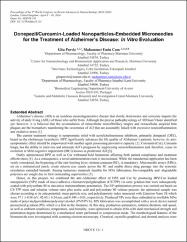Donepezil/Curcumin-Loaded Nanoparticles-Embedded Microneedles for the treatment of Alzheimer’s disease: In vitro evaluation
Citation
Parviz G.; Çam, M. E. Donepezil/Curcumin-Loaded Nanoparticles-Embedded Microneedles for the treatment of Alzheimer’s disease: In vitro evaluation. 9th World Congress on Recent Advances in Nanotechnology, RAN 2024, London, Code 311889.Abstract
Alzheimer’s disease (AD) is an insidious neurodegenerative disease that slowly deteriorates and seriously impairs the activity of daily living (ADL) of those who suffer from. Although the precise pathophysiology of AD hasn’t been identified yet; however, it is believed that the accumulation of intracellular neurofibrillary tangles and extracellular amyloid beta plaques are the biomarkers manifesting the occurrence of AD that are assumably linked with excessive neuroinflammation and oxidative stress [1]. The current treatment strategy is symptomatic relief with acetylcholinesterase inhibitors, primarily donepezil (DPZ), based on the cholinergic hypothesis. DPZ significantly advances the life quality of Alzheimer’s patients; however, its antisymptomatic effect should be empowered with another agent possessing preventive capacity [2]. Curcumin (Cur), Curcuma longa, has the ability to intervene and attenuate AD’s prognosis by suppressing neuroinflammation and, therefore, cease its evolution at Mild cognitive impairment (MCI) known as prodromal AD [3]. Orally administered DPZ as well as Cur withstand bold limitations affecting both patient compliance and treatment effectiveness [4]. As a consequence, a novel administration route is necessitated. While the transdermal application has been vastly considered, the bypassing of the rate-limiting layer, stratum corneum (SC), is mandatory. Microneedle arrays (MNs), set on a miniaturized patch, create micron size canals across the SC and enable direct drug passage into the systemic circulation extended beneath. Among numerous materials feasible for MNs fabrication, bio-compatible and -degradable polymers are sought due to their outstanding superiorities [5]. Hence, in this project, we combined the anti-Alzheimer effect of DPZ and Cur by producing DPZ/Cur loaded nanoparticles (NPs) made of muco-adhesive chitosan/tripolyphosphate (CS/TPP) via ionic gelation that were subsequently coated with polysorbate 80 to maximize transmembrane penetration. The NP optimization process was carried out based on CS:TPP mass and solution volume ratio plus acetic acid and polysorbate 80 volume percent; the optimized sample was chosen according to its zeta potential, mean particle size, and polydispersity index measured with Zetasizer Nano 2S which were 37.1 ± 0.56 mV, 42.63 ± 0.24 nm, and 0.344 ± 0.01, respectively. Produced NPs were then embedded in swellable MNs made of polyvinylpyrrolidone/polyvinyl alcohol (PVP/PVA). MN fabrication was accomplished with a novel device named pressurized gyration (PG) which is a first in the literature. In this step, production parameters, rotation duration, and speed, as well as ambient conditions, temperature, and humidity, were optimized to obtain MNs with ideal mechanical strength and penetration degree determined by a mechanical tester performed in compression mode. The morphological features of the biomaterials were investigated with scanning electron microscopy. Chemical, crystallo-graphical, and thermal analyses were concluded with Fourier-transform infrared spectroscopy, X-Ray powder diffraction, and differential scanning calorimetry, respectively. Encapsulation efficiency % and loading capacity % were measured as 70.12 and 34.78% for DPZ, 69.57 and 53.2% for Cur, respectively. Furthermore, drug release analysis demonstrated that both drugs were released based on Higuchi kinetic model via non-Fickian diffusion mechanism. Additionally, NP’s degradation and MN’s swelling patterns were thoroughly investigated. Finally, the bio-safety and -efficacy of synthesized materials were assessed on Aβ1−42-induced SH-SY5Y in vitro Alzheimer models.
Source
World Congress on Recent Advances in NanotechnologyURI
https://avestia.com/RAN2024_Proceedings/files/paper/NDDTE/NDDTE_131.pdfhttps://hdl.handle.net/20.500.12780/927


















